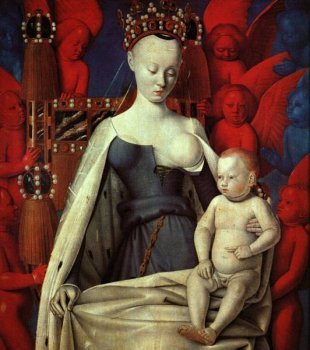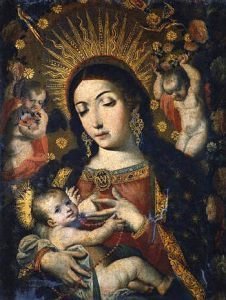Chatillon-sur-Seine
Our Lady of All Graces,
Our Lady the Great,
Our Lady of St. Bernard,
Our Lady of the Castle
In the 11th century church Saint Vorles, 4 Espl. Saint-Vorles, Chatillion-sur-Seine is 45 minutes NW of Dijon, Côte d'Or department, Burgundy region, replacement for 12th century original that was burnt in the 18th century, 78 cm.
It seems that St. Bernard of Clairveaux (1090-1153) prayed before this, to me rather pale looking, but nonethless Black and miraculous Madonna, who was restored in 1927. She had been hidden in a farm garden during the Revolution. Her miracles include the resuscitation of dead babies, but what made her perhaps the most influential Black Madonna in Europe was what she did for St. Bernard: the famous "lactation miracle".
There are several renditions of it. Here is one: When St. Bernard was still a sickly boy in cloister school, he suffered one day from a dangerous infection. Seeking relief, he went to pray before the Black Madonna. He was reciting the prayer 'Hail Star of the Sea' and when he came to the part: "Show yourself a mother!" the image suddenly came alive and squeezing her breast, let three drops of milk fall onto his lips. Not only was he instantly healed, body and soul, but his heart was enflamed with such love for the divine Mother that soon he would enkindle a burning devotion to her all over Europe.
Alfonso Cano, the Vision of St. Bernard, 1650
He expressed his experience with an inspired theology that earned him the title 'Marian doctor of the Church.' During one famous sermon he called Mary our 'Aqueduct Of Divine Grace' saying: "This stream [Christ] from the heavenly source [God the Father] descends to us through an aqueduct [Mary]; … The aqueduct itself is always full, so that all may receive of its fullness, yet not the fullness itself. … an Aqueduct which, receiving the fullness of the Fountain from the Father's heart, has transmitted it to us, if not as it is in itself, at least in so far as we could contain it."¹
Presently people say, while receiving milk from the heavenly Mother, Saint Bernard was initiated into supreme consciousness and adopted as the son of God and Mary. The more medieval wording was that Mary filled him with all divine graces and purified all his sins. Hence her title "Our Lady of All Graces".
As the fame of Saint Bernard spread and his theology justified great Marian devotion, Christians all over Europe started dreaming about being suckled by the virgin-mother for the salvation of their souls. Maybe they tapped into an ancient urge and experience of being nurtured at the breasts of a heavenly mother. Since pre-historic times the divine was portrayed as a woman offering her breasts to all God's children.
Here are relatively late examples:
Left: A 2nd millennium B.C. Philistine goddess-vessel that sprouts from the breasts, excavated near Tel Aviv, Israel. (Philistine as in Samson the Philistine and Delila.)
Middle: Ishtar/Innana the Middle-Eastern goddess venerated since the 3rd millennium B.C. She is often mentioned in the Bible. Her titles include: Mother of the Fruitful Breast, Queen of Heaven, Light of the World, Creator of People, Mother of the Gods, River of Life.
Right: The 'Virgin of the Milk' by Pedro Machuca, Spain, 1517 A.D. Mary and Jesus squeeze her breasts for the salvation of many; some milk spills onto her dress and souls in purgatory hope it'll trickle down to them.
Christians honored Mary's mother's milk from the first century on. They held as sacred a white powder that was scraped from the walls of the shelter in Bethlehem where Jesus presumably was born. Later that white powder from the stable of the nativity was thought to be Mary's dried milk. Three "drops of this milk" eventually made it into a medallion that emperor Charlemagne (742-814) used to carry into battle.²
After Bernard's 'lactation miracle' and with the help of his theology, Mary's milk started flowing all over Europe. After all the saint had prophesied: "we approach the altar of God and pray, and, if we persevere, despite our own dryness and tepidity, grace will overpower us, our bosom will swell, love will fill our hearts…and the milk of sweetness will overflow everywhere in a torrent."³
In the UK, images of the type called virgo lactans by art historians are affectionately known as “the first supper”. This one is in St. Nicholas Cathedral in Newcastle and the only stained glass in that church that was spared during the English civil war (1642 through 1651). photo by Vincent Lowe
Most of the important Marian shrines eventually claimed to possess vials containing a few drops of the Virgin's milk. (The reformer John Calvin mocked that even a milk cow or a wet nurse couldn't have produced as much milk as the Holy Virgin!) A new type of Madonna appeared in many churches and chapels: Maria lactans or virgo lactans, the nursing virgin bearing her breast. Paintings showed her not only squirting milk at Saint Bernard but her motherly love overflowing so abundantly that even the thirst of ordinary Christians and souls in purgatory was quenched. Jesus got the milk of graces flowing, but now it flowed for all.
Modern thinkers criticize that the very idea of a holy virgin-mother constitutes an attack on a healthy, natural relationship to the human body and sexuality. Yet here we see examples of great comfort with the human body and a wonderful way to use sexual impulses in a transformative way (like tantra). Saint Bernard's great appreciation of sexual imagery in the service of enlightenment and divine union is further apparent in his almost exclusive predilection for the Song of Songs, this erotic love poem in the Bible.
Over time however, the barrier between the Most Holy Virgin and ordinary sexual desire became thinner and thinner and the Church more and more uncomfortable with all those big, round, supposedly lactating breasts. The breaking point was reached in the fifteenth century when King Charles VII of France commissioned a painting of his mistress as the Virgin with Child. Baby Jesus looks uninterested, even discontent with the breast he knows to be dedicated to the French rather than the Heavenly King. The painting caused enough of a scandal that the Church began to dissuade images of bare breasted or lactating Madonnas and so they became rare.
It took the Heavenly Mother a couple of centuries to respond. (She's never in a hurry.) Then she started to try and quench the thirst of her children by shedding salty tears rather than sweet milk. All over the world icons, statues, and road side reliefs have miraculously wept tears of water or blood - not as fun a meditation, but also a life giving secretion from the divine Mother.⁴
'The Virgin of Belén' by Bolivian painter Melchor Pérez de Holguín early 18th century.
Rome of course, is far away from many parishes who are not so concerned about Papal wishes. And so many artists still happily portrayed lactating Madonnas. Here is a particularly beautiful one whose milk is transformed into rosary beads. (Detail on the right.) What a wonderful contemplation to think you are being nourished with divine mother's milk when you pray the rosary! According to the artist, each Hail Mary contains a drop of Mary's saving milk.
Here is a modern painting from 2004 by the Spanish artist Vicente Valls. It hangs in the church St. Michael the Archangel in Burjassot, Spain. It seems to draw a parallel between on the one hand the sacred blood of Christ, which flows from the chalice and sanctifies the disciples of Jesus, forming their halos, and on the other hand the milk of Mary poured out not just for Jesus but for all. - This may all seem very strange and improper, even disgusting to American Puritan sensibilities, but it really is no less weird and no less spiritual than meditating that one is "washed in the blood of Christ" or eats the body of Christ.
A beautiful article in the on-line journal of the "National Museums Liverpool" explains the connection between Mary's milk and Christ's blood. Medieval Christians recognized that since Jesus' body grew from and was nurtured by Mary's body, one cannot be separated from the other.⁵
It's all about union, union with God in body and spirit.
Footnotes
1. St. Bernard of Clairvaux, Sermon For the Feast of the Nativity of the Blessed Virgin Mary (also called On the Aqueduct Of Divine Grace). In: Sermons for the seasons and principal festivals of the year, volume 3, The Carroll Press, Westminster, MD 1950, p. 284ff.
2. Marie-France Boyer, The Cult of the Virgin: Offerings, Ornaments and Festivals, Thames & Hudson, London: 2000, pp.26-30
3. Quoted in on line article of the National Museums Liverpool: ‘Rest on the Flight into Egypt’
4. E.g. in Rho, Italy a painting cried tears of blood in 1583, in La Salette, France an apparition cried tears in 1846, in Syracuse, Sicily a statue cried tears in 1953, in Akita Japan a statue cried tears in 1973, in Naju, South Korea a statue cried tears of blood in 1985, in Cuenca Ecuador a statue cried tears in 1988. For many more examples in modern times visit: www.crystalinks.com/weepingstatues.html
5. Op cit. www.liverpoolmuseums.org.uk











